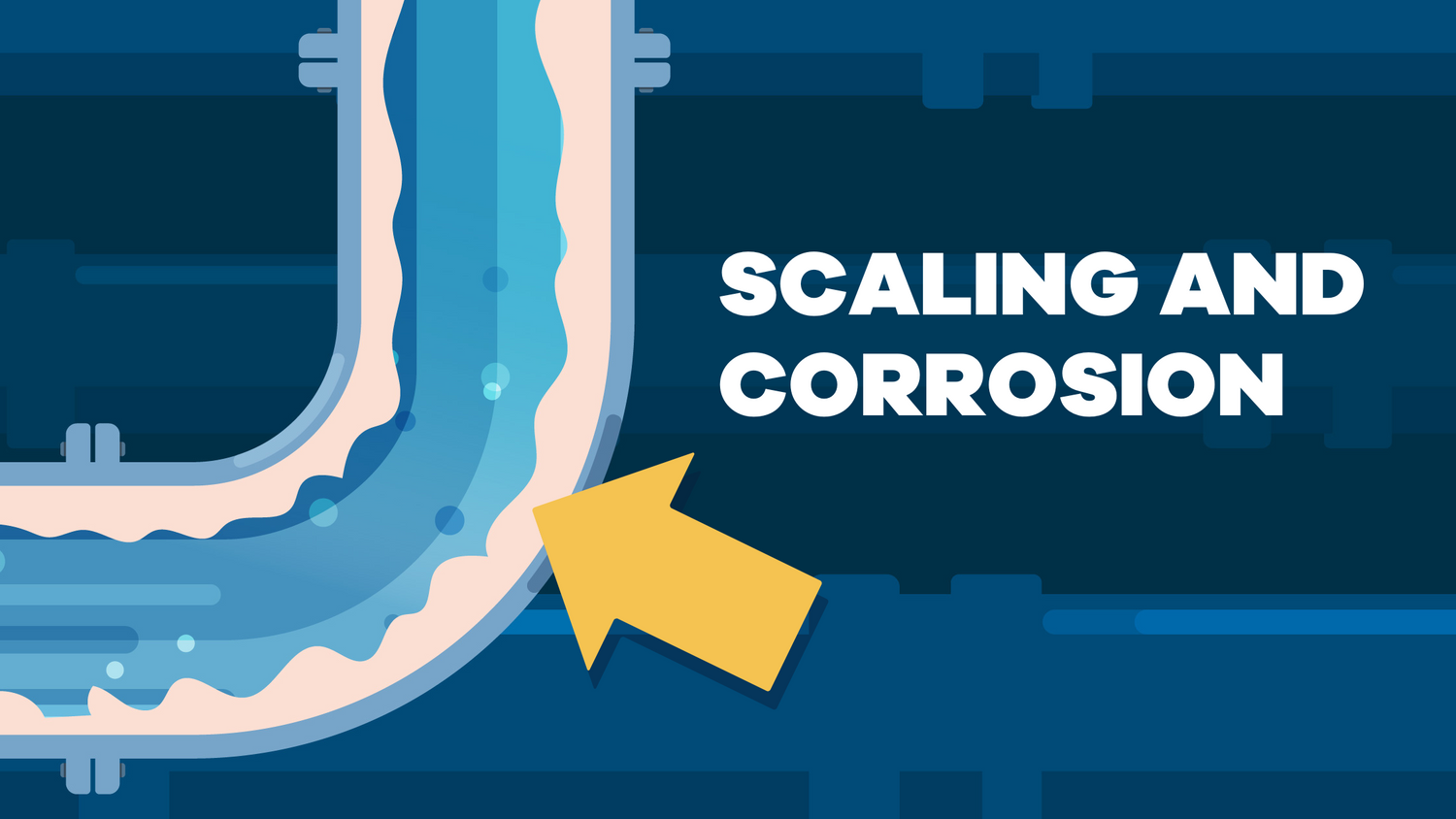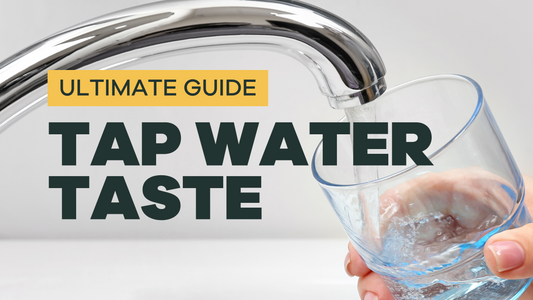
Scale, Corrosion, and Plumbing: What You Need to Know
Our blog is written by real experts— not AI. Each guide is carefully reviewed and updated based on the latest research. Plus, with no affiliate links, you can count on unbiased insights you can trust.
In this informative guide to understanding how household water quality impacts plumbing, we’ll be focusing on two of the major processes that impact your water pipes: corrosion and scaling. What are they? How are they related? And what can you do to prevent expensive failures in your pipes and fixtures?
The interaction between your pipes and the water flowing through them is a complex mixture of physical, chemical, and biological processes. We’ll tease out these subtleties below.
Table of Contents:
- What Is Corrosion?
- What Are the Different Types of Corrosion?
- What Is Scale?
- How Do I Know if My Pipes Are Susceptible to Corrosion or Excessive Scaling?
- What Can I Do to Prevent Corrosion or Excessive Scaling?
- What's the Takeaway?
What Is Corrosion?
Corrosion is a process that occurs when there is an electrochemical reaction between a metal (in our case, the pipe wall) and water. The result of corrosion is the oxidation of metal on a pipe wall, after which metal is released into the water or reacts with components present in the water, creating a new compound that adheres to the pipe wall.
Two Types of Corrosion
-
The best known example of corrosion is the type that releases metals into the water, metals that are often a health concern. Plastic and cement pipes can leach compounds into water and degrade as well, but we'll be focusing on metal pipes alone.[1]
Around two-thirds of municipal water infrastructure is made of legacy materials like iron, steel, and lead. Even though the use of materials containing lead was banned in public drinking water system in 1986, over 9.7 million lead service lines remain in use connecting homes to municipal water mains.[2][3] Household plumbing and fixtures can pose corrosion risks as well, especially in older homes, as they may be made of a variety of metals and/or alloys, many of which include lead solder.
- The second type of corrosion does not release metal from the pipe wall. Instead, the corroded metal stays on the pipe wall as newly bound up metal and pipe material. This newly bound up metal is a type of scale. Scale is simply the build up of minerals and other compounds on pipe walls.
While corrosion can occur without scale and scale can exist without corrosion, they often occur together and feed into one another. This second type of corrosion can be called "oxidation scale."
What Does Corrosion Look Like?
Corrosion can appear as a build up of material inside the pipe (oxidation scale), the thinning or rupturing of pipe walls, or both! Oxidation scale typically looks rusty and can be somewhat smooth (like in the lead pipe in Figure 1), or lumpy (like the tuberculation—or formation of metal lumps—in the iron pipe in Figure 2). "Pinhole leaks," tiny holes in the pipe wall, are another common consequence of corrosion and are known to occur in copper pipes.

(Terese Olson, Researchers estimate amount of lead released from Flint water pipes). [4] Figure 1: Interior of a lead service line from Flint, MI.

(Shutterstock).Figure 2: Tuberculation in a corroded iron pipe.
What Are the Different Types of Corrosion?
There are three common types of corrosion: uniform, non-uniform or localized, and galvanic.
- Uniform corrosion occurs across the entire pipe wall, while
- Non-uniform corrosion occurs in a much more localized fashion due to either impurities in the pipe materials or localized water quality differences (e.g., tuberculation and pinhole leaks).
- Galvanic corrosion is a bit of a different mechanism. Galvanic corrosion can occur in places where dissimilar metals are joined together, such as lead solder joining copper pipes.
All three of these types of corrosion can result in the build up of oxidation scale or the release of metals from the pipe wall, depending on pipe materials and water quality conditions.
How Can Corrosion Impact My Pipes?
If pipes are left to corrode for long periods of time, eventually they will clog with oxidation scale and/or be eaten away to the point of rupturing. In addition to having to replace your plumbing, you can imagine what that could mean for your house and belongings.
How Can Corrosion Impact Me?
In addition to damaging your plumbing, corrosion can impact the aesthetics of your water as well as your health.
-
Corrosion can cause noticeable changes to the taste and color of your water. For example, a rusting iron pipe may cause your water to take on a brownish color and metallic taste if the rust is sloughed off into the water.
- Corrosion can potentially release toxic metals, which are usually tasteless, colorless, and odorless in drinking water. Lead doesn’t cause taste, color or odor problems, but can be highly toxic in low concentrations.
7 Heavy Metals Everyone Should Test For
What Is Scale?
As we mentioned above, scale is the build up of minerals and other compounds on the inside of pipes. This is likely to occur in pipes of any material: metal, plastic, cement, etc. Ideally, there is a moderate amount of scale in pipes to protect them from corrosive conditions that result in metal release. But scale becomes problematic when it gets excessive.
What Does Scale Look Like?
Scale looks different depending on what process is forming it and what else is in the water. Scale created by or downstream of corrosion often looks rusty (Figure 3), while scale exposed to manganese can look black. On the other hand, scale primarily made up of calcium carbonate (or limescale) has a whitish color (Figure 4).

(Shutterstock).Figure 3: A new pipe joint and a joint after years of use, containing significant amounts of scale.

(Shutterstock).Figure 4: Pipes with excessive limescale build up.
What Are the Different Types of Scale?
There are two main types of scale that may form in pipes.
-
The first is the one we briefly discussed in the corrosion section, which we’re calling "oxidation scale." Oxidation scale is caused by the direct reaction of the water and the pipe material. When oxidation scale is insoluble and durable, it is protective for pipes and prevents further corrosion; this specific type of oxidation scale is referred to as a passivating film.
However, when oxidation scale is highly soluble and friable (i.e., it crumbles easily), it can become problematic. These unstable scales can come off of the pipe wall to release corrosion products into the water; they can also become thick enough to impact the flow of water through pipes. Additionally, rather than protecting pipes from corrosion, this type of scale allows corrosion to continue at the surface of the pipes, thereby continuing to build up.
-
The second type of scale that can be present in pipes is caused by the deposition of materials from the water onto the pipe walls. Let’s call this "deposition scale." This type of scale can result in what we call excessive scale, which can cause problems for your plumbing and appliances. The most well known cause of excessive scale is calcium carbonate, or limescale.
How Can Excessive Scale Impact My Pipes?
If scale is allowed to build to excessive amounts, it eventually clogs your pipes and results in costly repairs.
The conditions that cause scale to build up in your pipes also cause scale to build up on other things, like appliances and fixtures. Over time, this can reduce the service life of your appliances, which can get costly quickly. Scale build-up is most common in appliances like water heaters (Figure 5). The white spots you may be familiar with are typically limescale, which becomes less soluble as water temperature increases (thus deposits from water onto a surface).

(Shutterstock).Figure 5: The heating element of a water heater being replaced after excessive scale buildup rendered it nonfunctional.
How Can Excessive Scale Impact Me?
In addition to potentially damaging pipes and appliances, excessive scale can also be a nuisance. The water quality conditions that cause limescale, namely high water hardness, can cause issues with skin and hair: dry and brittle hair, dry skin, and even the exacerbation of eczema.
How Do I Know if My Pipes Are Susceptible to Corrosion or Excessive Scale?
The short answer is: there is no easy way to know for sure whether your pipes are safe from excessive scale or corrosion. However, we’ve identified a variety of indicators that you can test for which can help you get a pretty good idea of what’s going on.

The first thing we look at when thinking about the conditions of pipes is the water flowing through them. The table below shows four water quality characteristics that SimpleLab identified as the most important and readily measurable indicators of pipe health. Each characteristic has a range of values that we recommend to maintain optimal pipe conditions.
| Parameter | Description | Recommended Range | Relevant Process |
|---|---|---|---|
| pH | pH is a measure of the acidity of water, with low pH indicating potential corrosivity and high pH indicating the potential for excessive scale | 6.5 - 10 | Corrosion & excessive scaling |
| Alkalinity | Alkalinity is a measure of water's ability to neutralize acid | >30 mg/L as CaCO3 | Corrosion |
| Chloride-to-Sulfate Mass Ratio (CSMR) | CSMR is the ratio of chloride to sulfate concentration; sulfate is thought to have a protective effect in pipes and chloride a corrosive effect. High CSMR with low alkalinity is cause for significant concern. | <0.2 | Corrosion |
| Langelier Saturation Index (LSI) | LSI is an indicator of the tendency for calcium carbonate scale to deposit; it is calculated using alkalinity, pH, calcium concentration, temperature, and total dissolved solids | <3 | Excessive scaling |
There are many other factors that can shed light on the potential for corrosion and scaling in pipes, including the water’s temperature, disinfectant type, dissolved oxygen, stagnation time and the pipe material and age.

These factors are much harder to assess when compared to the five parameters we use as indicators of pipe health.
Where Can I Get My Water Tested?
What Can I Do to Prevent Corrosion or Excessive Scaling?
If you rely on a public water utility, it is likely that your water already contains a corrosion inhibitor, which creates a passivating film inside pipes that protects them from harmful corrosion (Figure 6). However, there are many different types of corrosion inhibitors and no guarantee that the most appropriate one is being used or has made it all the way to your household plumbing. And, of course, many people do not use public utility water.
Therefore, we recommend testing, treating, and monitoring in order to assess your corrosion or scale situation. In addition, you should consult a plumbing professional if you’re experiencing any noticeable issues with your plumbing system.
Figure 6: Drinking water pipes without corrosion inhibitor (far left) and with corrosion inhibitor (three remaining pipes with white coating).[5]
Testing
The first step in preventing damage to your plumbing is testing your water. Testing offers you a good understanding of the four water quality parameters we discussed above. Our Essential City Water Test and Essential Well Water Test both measure all of those parameters plus a wide range of metals, which could be present if your pipes and fixtures are corroding.
Every Tap Score report includes a plumbing section that evaluates whether any of the four pipe health indicators are outside of their recommended ranges, and/or whether there are any dissolved metals present (which can indicate corrosion). SimpleLab uses this data to identify a range of treatment options that can help maintain the integrity of your plumbing system.
Treatment
Treatment technologies consist of either point-of-entry (POE) or point-of-use (POU) systems. For mitigating problems with scaling and corrosion, a POE system is required. A POE system treats water as soon as it enters your house and will therefore protect your on-site plumbing and fixtures. A POU system, on the other hand, treats the water at the point of use (for example, an under-sink unit or pitcher filter) and will not protect your plumbing system.
The type of treatment you install depends on which of the water quality characteristics need adjusting, as well as any other health or aesthetic concerns you identify through testing. With Tap Score, you can consult with one of our professionals before you make a final decision.

POE Versus POU Water Treatment
A few example treatments that address potential corrosion or excessive scaling are shown in the table below.
| Treatment Name | Description | Parameter Addressed |
|---|---|---|
| pH adjustment | Injection of acidic or alkaline solution | pH, alkalinity |
| Water softener | Exchanges Ca2+ and Mg2+ ions with Na+ or K+ ions | Hardness, alkalinity, LSI |
| Reverse osmosis filter | High pressure membrane filter | Hardness, alkalinity, LSI, metals |
Monitoring
After you’ve tested and installed treatment, you’ll want to conduct follow-up testing to ensure your treatment is working over time.
What's the Takeaway?
- Corrosion is the oxidation of metal on a pipe wall. Either it causes metal to be released into the water flowing through a corroded pipe, or it reacts with components present in the water to create a new compound that adheres to the pipe wall as a type of scale
- Corrosion that degrades pipe material can leach compounds into the water that are harmful to your health and, left untreated, result in costly pipe disintegration and rupture
- Scale is mineral build-up inside of pipes. Moderate scale protects pipes from excessive corrosion, excessive scale can clog up your pipes and cause damage to your plumbing and fixtures
- Four water quality characteristics can be reliable indicators of pipe health: pH, alkalinity, CSMR, and LSI.
- Laboratory water testing offers you a glimpse at all those characteristics and more, which help you better understand whether or not your pipes are at risk of excessive corrosion or excessive scale
Read More
▾The Drinking Water Taste Guide
The Complete Guide to Discolored Water
7 Heavy Metals Everyone Should Test For
What's the White Residue on My Fixtures?
Is My Water Ruining My Hair?
General Chemistry of Water
Where Can I Get My Water Tested?
What Happens to Stagnant Water in a Vacant Building?
Sources and References
▾- Contaminant Migration From Polymeric Pipes Used in Buried Potable Water Distribution Systems: A Review | Whelton and Nguyen
- Condition Assessment of Ferrous Water Transmission and Distribution Systems | EPA
- Lead Pipes Are Widespread and Used in Every State | NRDC
- Researchers estimate amount of lead released from Flint water pipes
- Hardness in Drinking-water
- Here's what drinking water pipes look like with and without corrosion control
Optimal Corrosion Control Treatment Evaluation Technical Recommendations for Primacy Agencies and Public Water Systems | EPA
Corrosion Control Principles and Strategies for Reducing Lead and Copper in Drinking Water System | Shock and Lytle
Corrosion Manual for Internal Corrosion of Water Distribution Systems | EPA
Impact of Chloride: Sulfate Mass Ratio (CSMR) Changes on Lead Leaching in Potable Water | Nguyen, Stone, Clark, Edwards, Gagnon and Knowles
Guidance on Controlling Corrosion in Drinking Water Distribution Systems | Health Canada
Guidelines for Canadian Drinking Water Quality: Guideline Technical Document – pH | Health Canada










